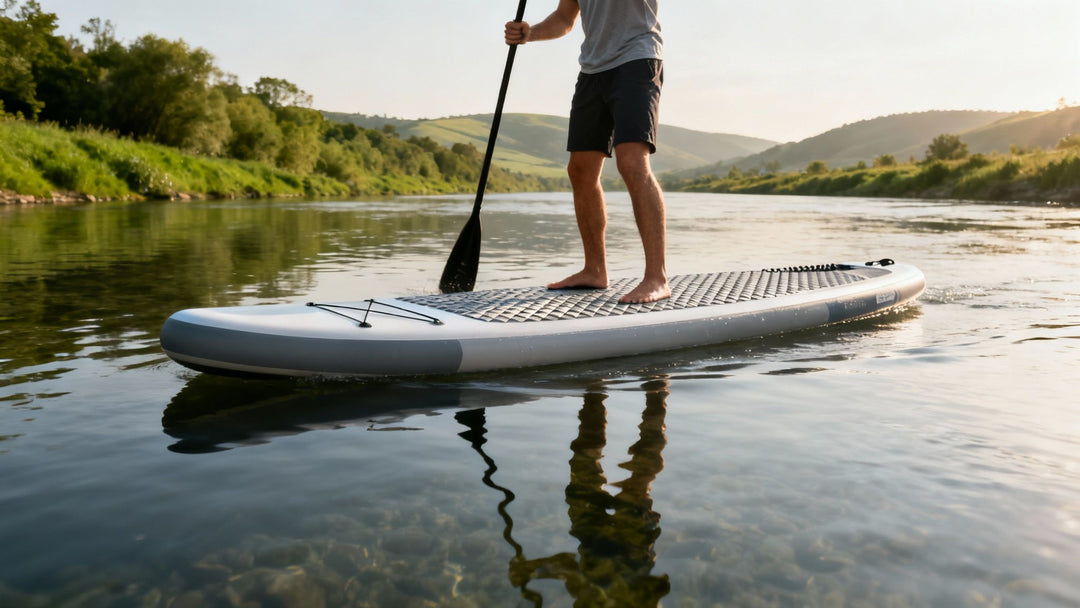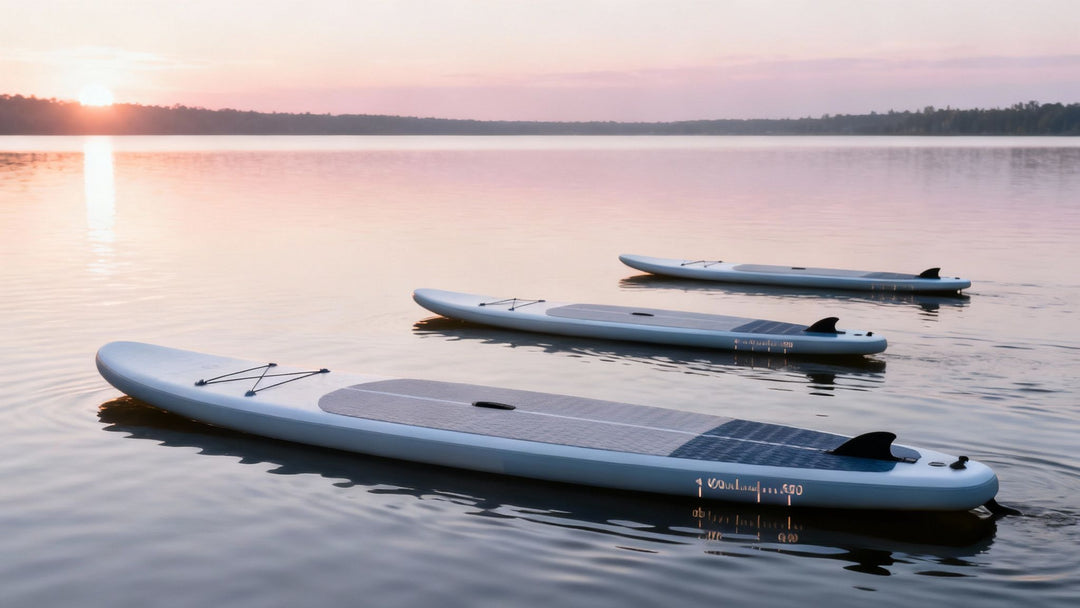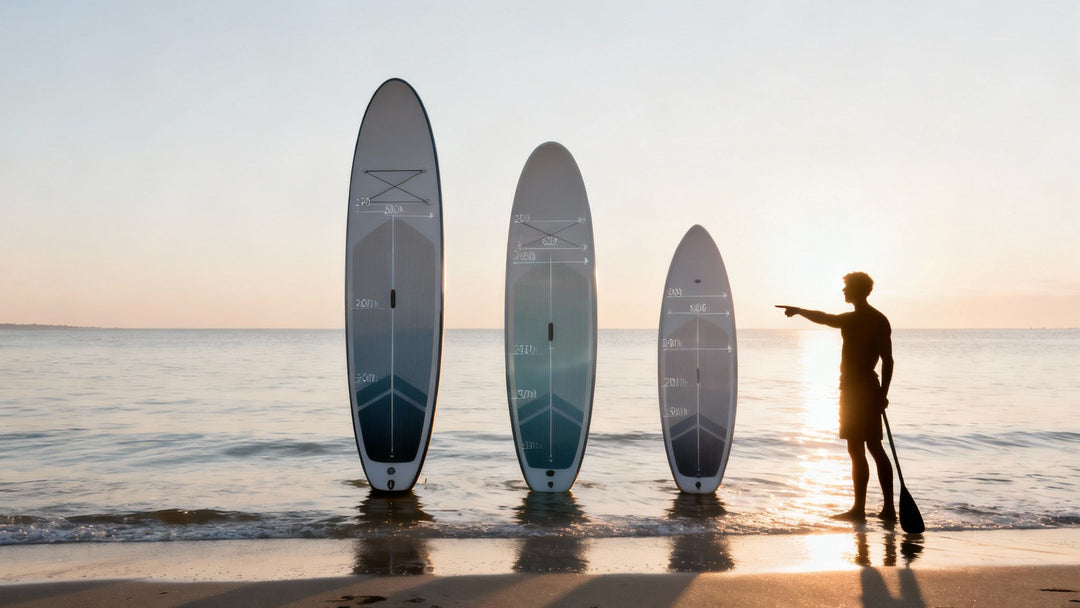SUP Board Size Guide to Find Your Perfect Board
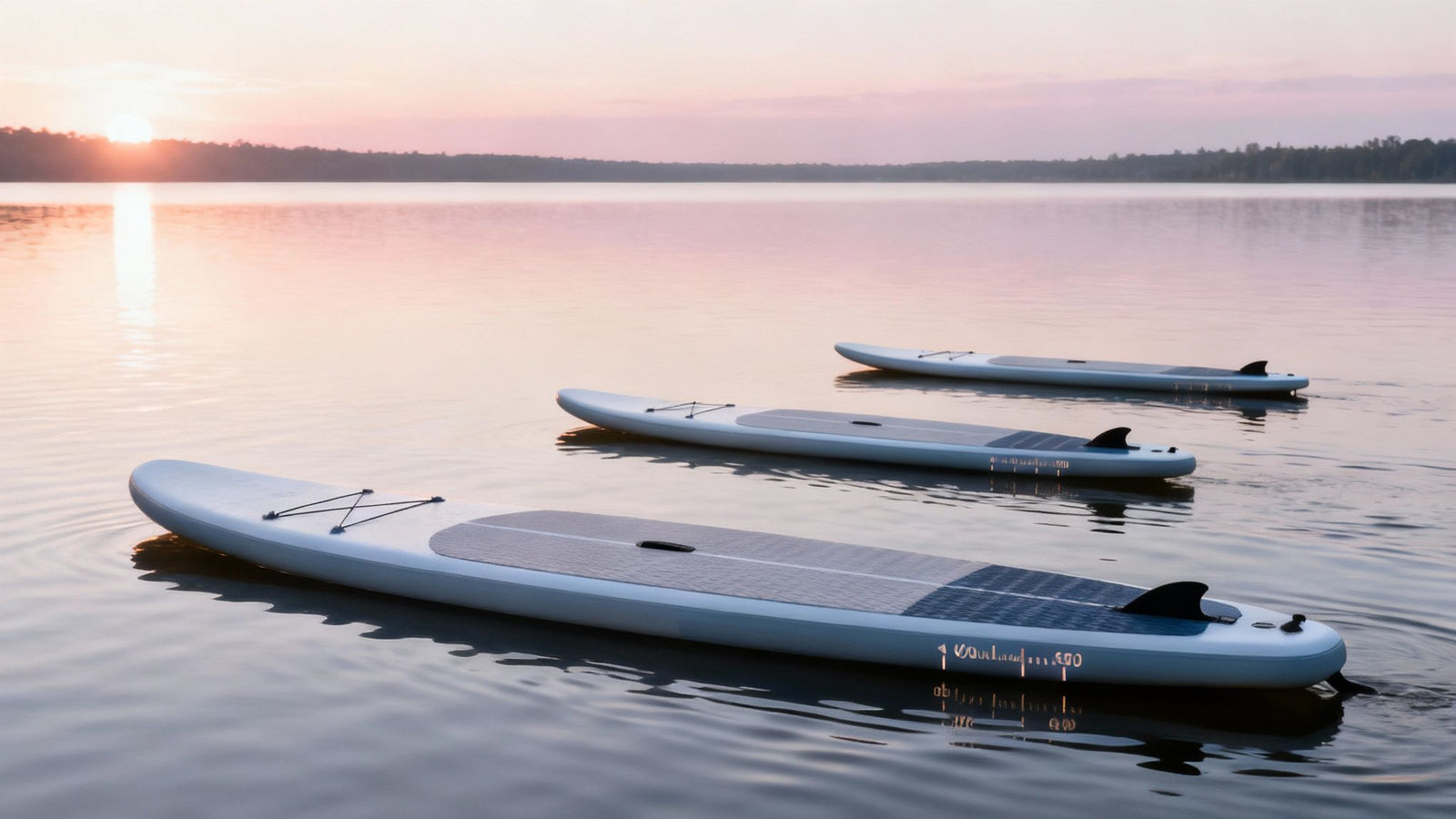
Choosing your first stand-up paddle board is exciting, but let's be honest, the sheer range of sizes can feel a bit overwhelming at first. Don't worry. Your perfect board size really boils down to three things: your weight, your skill level, and where you'll be paddling. This guide is here to cut through the noise and give you the foundational knowledge you need to choose with confidence.
Finding Your Perfect SUP Board Size
Getting the right board size is probably the single most important decision you'll make for having a great time on the water. It’s a bit like choosing the right size bike; a frame that’s too big or small will just feel awkward, unstable, and no fun to ride.
It's the same with a SUP. A board that's too small for your weight will sink too low, making it feel tippy and a real struggle to paddle. On the flip side, a board that's way too big for you can feel sluggish and hard to turn, like trying to steer a barge. The goal is to hit that sweet spot between stability and performance that works for you.
For example, a heavier beginner needs a board that’s wide and stable with plenty of volume to feel secure and build up confidence. A fantastic example is the Loco Amigo Air iSUP; it offers tons of stability, letting you focus on learning your basic strokes without constantly worrying about taking a swim.
In contrast, a lighter, more experienced paddler can get away with a narrower, lower-volume board. This gives them better speed and agility, perfect for covering more distance or even catching a few waves.
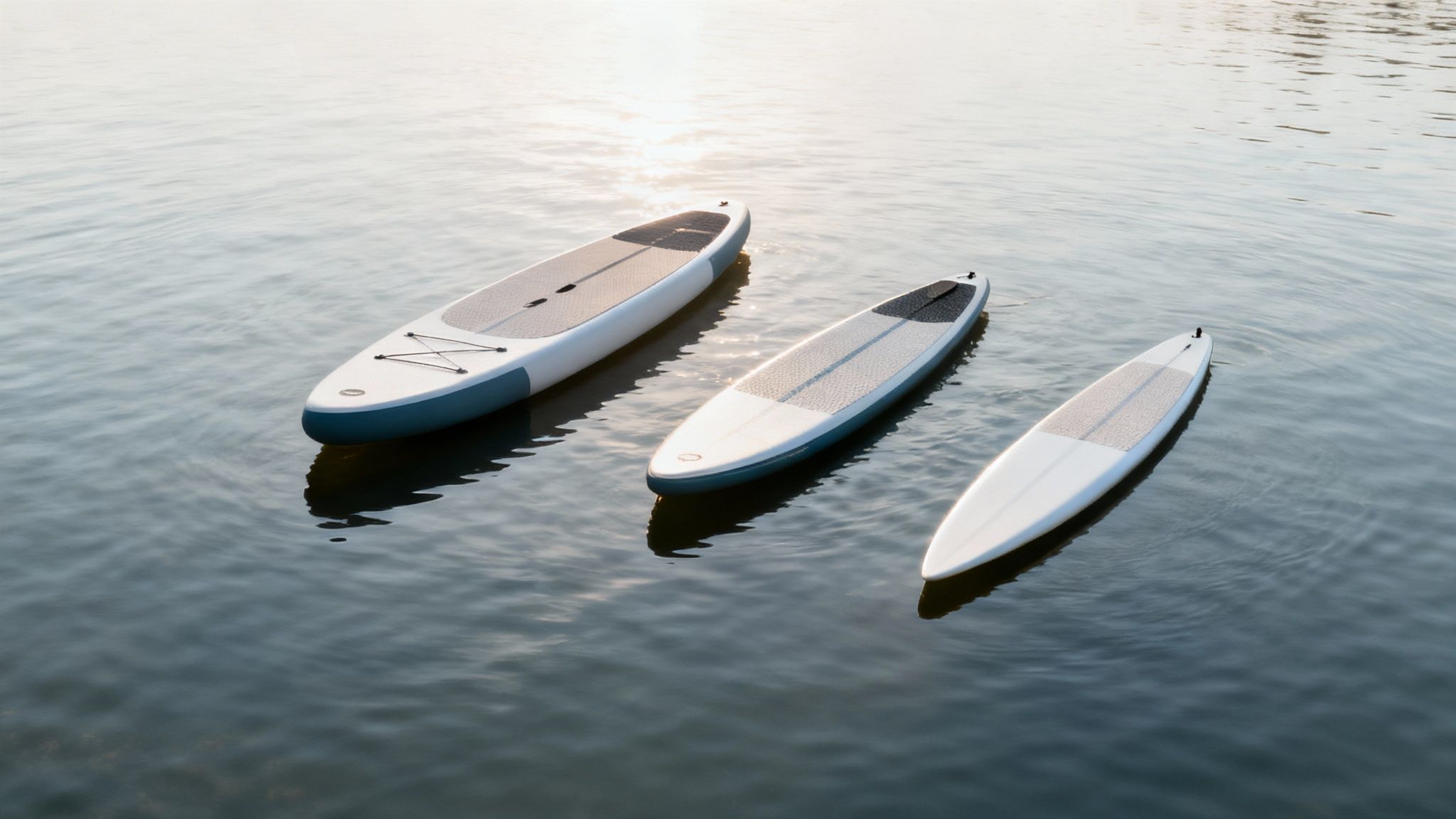
Quick Size Recommendations
To give you a simple starting point, we've put together a straightforward table. Think of this as a quick reference to match your weight and skill level with a recommended board volume and some typical all-round dimensions. Volume, measured in litres, is the best indicator of how well a board will support you.
Quick SUP Volume and Size Recommendations by Rider Weight
Use this table as a starting point to match your weight and skill level with the appropriate board volume and typical all-round dimensions.
| Rider Weight (kg) | Beginner Volume (Litres) | Intermediate/Advanced Volume (Litres) | Typical All-Round Board Size |
|---|---|---|---|
| 50-70 kg | 170-220 L | 120-170 L | 10'6" x 32" |
| 70-90 kg | 220-270 L | 150-220 L | 10'6" x 32" or 10'8" x 33" |
| 90-110 kg | 270-320 L | 180-250 L | 10'8" x 34" or 11'6" x 34" |
| 110+ kg | 320+ L | 220-300+ L | 11'6" x 34" or larger |
Just remember, this chart is a guideline. Factors like the type of paddling you want to do will also influence your final choice, but it’s an excellent place to begin.
Key Takeaway: If you're ever in doubt, it’s always better to go for a board with slightly more volume than you think you need. That extra bit of stability makes the learning process so much more enjoyable and gives you the versatility to carry extra gear or even a small passenger (like a child or dog) later on.
Getting a handle on how your weight and experience affect your board choice is the first major step. It helps you look beyond just the length and width and focus on the specs that truly matter for performance and fun. As you explore the different types of boards in this guide, you'll be able to connect these core concepts to specific models, making sure you pick the perfect board right from the start.
Why Board Volume Is Your Most Important Number
When you’re looking at a row of paddle boards, it’s natural to focus on the obvious stuff like length and width. But the single most important number you should be looking for is one you can't even see: its volume.
Measured in litres (L), volume is the best indicator of a board's buoyancy. In simple terms, it tells you how well the board will float and how stable it will feel once you’re standing on it.
Think of it this way. Imagine trying to stand on a small, thin log in the water. It would be incredibly wobbly and sink the moment you put any weight on it. Now, picture yourself on a big, wide raft. The raft has tons of volume, so it floats high on the water and gives you a solid, steady platform. Paddle boards work on exactly the same principle.
Understanding Buoyancy and Rider Weight
The physics here is pretty straightforward: one litre of volume displaces one kilogram of water. For a board to support you properly, its volume in litres needs to be a lot higher than your weight in kilograms. If those numbers are too close, the board will sit low in the water, feel sluggish, and be an absolute nightmare to balance on.
A 90kg rider hopping on a board with only 150L of volume, for example, is going to have a rough time. The board will be partly submerged and feel incredibly tippy. But put that same rider on a board with 250L of volume, and they'll feel confident and balanced as it floats high and dry. This is why getting your head around volume is so crucial to having a good time out there.
This infographic breaks down the simple calculation for figuring out your recommended board volume.
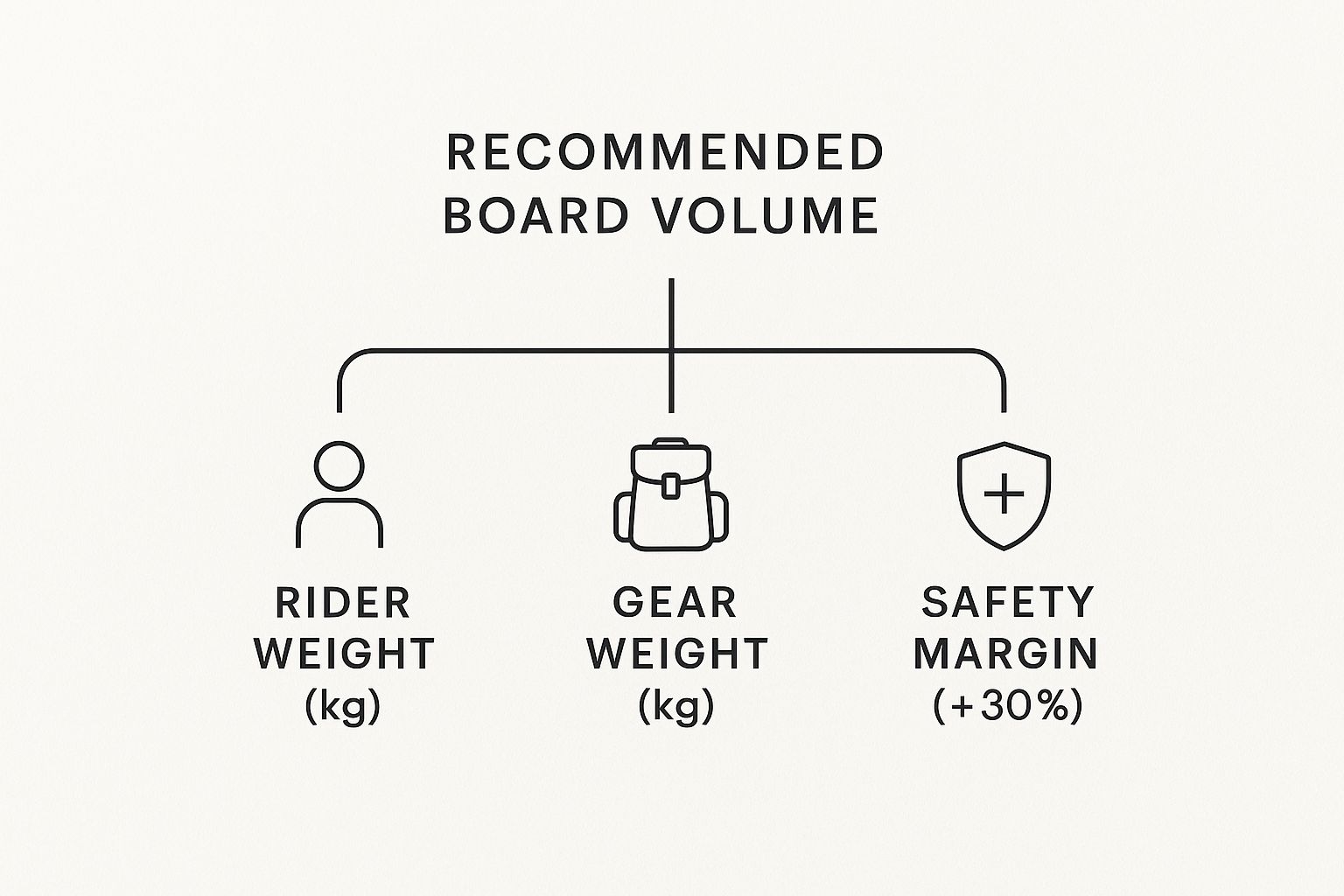
As you can see, it’s not just about your body weight. You also need to think about any gear you plan to carry, plus a bit of a safety margin to guarantee stability.
How to Calculate Your Ideal Volume
A solid rule of thumb for beginners is to find a board with a volume that’s at least double your weight. This gives you a generous amount of stability and makes the learning process a whole lot easier.
Here’s a quick formula to get you started:
- (Your Weight in kg + Gear Weight in kg) x 2 = Your Minimum Beginner Volume in Litres
A Practical Example:
Let's say you weigh 80kg and you plan on bringing a dry bag with some snacks and a drink, weighing about 5kg.
- Total Paddling Weight: 80kg + 5kg = 85kg
- Minimum Beginner Volume: 85kg x 2 = 170L
In this scenario, a board with a volume of 170L or more is what you should be looking for as a beginner. A board like the Loco Amigo Air, which often has volumes well over 250L, would offer a much safer and more enjoyable platform to learn on. For a deeper dive into matching these numbers to your specific needs, you might be interested in our complete guide on how to choose the right paddle board for your height and weight.
Expert Insight: While beginners need that high volume for stability, you'll notice experienced paddlers often choose lower volume boards. A board that sits closer to the water is far more responsive and manoeuvrable, which is exactly what you want for things like SUP surfing or racing where performance is everything.
As your skills improve, you'll probably find you can handle a board with less volume. But when you’re starting out, more volume is always your friend. It builds confidence, gives you the versatility to carry gear or paddle with a child, and ultimately makes sure you have fun from your very first session. Getting this number right empowers you to choose a board based on how it will actually perform for you, not just on its looks.
Right, so you've got a handle on how vital volume is for keeping you stable. Now we can get into the more obvious bits: the board's length, width, and thickness. These dimensions really define a board's personality and how it behaves on the water. They're tweaked for specific activities, whether you're planning a lazy paddle on the local lake or hoping to catch some proper waves.
Think of it like choosing a car. You wouldn't take a shiny sports car down a muddy farm track, and you wouldn't enter your family estate in a Grand Prix. Each vehicle is built for a purpose. It’s exactly the same with paddle boards – their shape dictates how they perform.
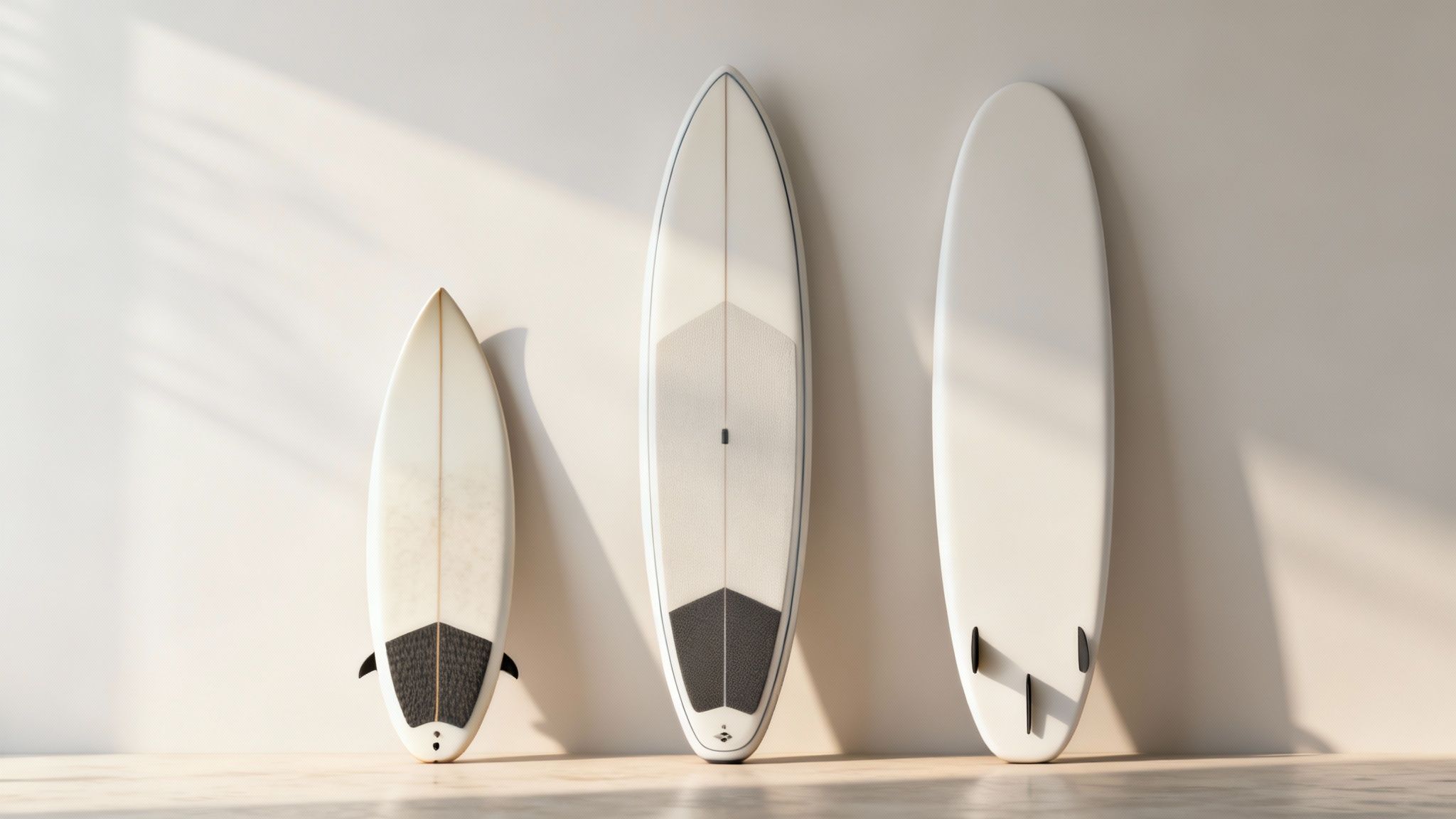
All-Round Boards: The Versatile Choice
All-round boards are the Swiss Army knives of the SUP world. They are the ultimate jack-of-all-trades. Typically, they measure between 10' and 11' long and 32" to 34" wide, hitting that sweet spot between stability and glide. This makes them a brilliant first board for beginners, families, or anyone who just wants one board that can handle a bit of everything.
That generous width gives you a solid, stable platform, which is exactly what you need when you're finding your feet. At the same time, the length isn't so massive that you can't turn it easily. You can take an all-rounder for a gentle paddle on a river, have a go at some SUP yoga, or even try your hand at catching some small, friendly waves.
Our Loco Amigo Air, for example, is a classic all-rounder. It’s designed to be forgiving enough for your first wobbly attempts but has enough performance packed in to keep things interesting as you improve. There's a reason these boards are so popular. In fact, the UK market mirrors global trends, with boards in the 10' to 11' category being the top sellers. It seems everyone loves a board that offers a great mix of stability, manoeuvrability, and portability.
Touring Boards: For Distance and Speed
If your idea of a perfect day involves paddling for miles and exploring new stretches of coastline, then a touring board is your ticket to adventure. These boards are noticeably longer (usually 11' and up) and sleeker than their all-round cousins. This refined shape, with what's known as a displacement hull, is all about cutting through the water with minimal fuss.
This efficient design translates into two key benefits:
- Better Glide: Every single paddle stroke sends you further across the water.
- Improved Tracking: The board holds its line, travelling straighter for longer, meaning you don't have to keep switching paddling sides.
The trade-off for all that speed is a little less stability because of the narrower width. That's why touring boards are generally a better fit for intermediate paddlers or beginners who are feeling confident. If you're serious about covering some distance, our guide on choosing touring paddle boards in the UK is packed with useful info. The Loco Motion Air is a perfect example of a touring board built for speed and comfort on long journeys.
A good way to picture the difference is to compare a canoe (the all-rounder) with a rowing scull (the touring board). The canoe is stable and can be used for lots of things, while the scull is long, narrow, and built for one thing: pure, efficient speed.
SUP Surfing Boards: For Agility on Waves
For anyone who feels the pull of the ocean and wants to ride waves, a dedicated SUP surfing board is a must. These are the shortest boards you'll find, often coming in at under 10' long. Their compact size makes them incredibly nimble and responsive, letting you carve sharp turns on the face of a wave.
They also have more rocker, which is the upward curve from the middle of the board to the nose and tail. This curve is crucial – it stops the nose from burying itself in the water as you drop into a wave and makes the board much easier to pivot. A board like the Loco Guppy Surf SUP is shaped specifically for performance in the surf, giving you the agility needed for tight, powerful turns.
SUP Board Type and Recommended Dimensions
To tie it all together, here’s a quick look at how different board types are optimised for specific paddling activities.
| Board Type | Typical Length | Typical Width | Best For | Loco Product Example |
|---|---|---|---|---|
| All-Round | 10' - 11' | 32" - 34" | Beginners, families, versatile use | Loco Amigo Air |
| Touring | 11' and up | 28" - 32" | Long distances, speed, straight-line tracking | Loco Motion Air |
| SUP Surfing | Under 10' | 27" - 31" | Riding waves, manoeuvrability, sharp turns | Loco Guppy Surf SUP |
| Yoga / Fitness | 10' - 11' | 34" and up | Maximum stability, yoga, fitness routines | N/A |
| Racing | 12'6" or 14' | Under 28" | Competition, maximum speed, experienced riders | N/A |
This table makes it easy to see the relationship between a board’s shape and its intended purpose on the water.
Specialty Boards: For Yoga and Racing
Beyond the main three categories, you'll find boards designed for very specific passions.
- SUP Yoga: Think of these as floating yoga mats. They're exceptionally wide (34" or more) and incredibly stable, with a large, comfortable deck pad that gives you plenty of room to stretch out and find your flow.
- Racing: Race boards are the Formula 1 cars of the SUP world. They are extremely long and narrow, designed for one thing only: maximum speed in a straight line. Balancing on one requires a serious amount of skill.
Understanding these different categories helps you line up a board's dimensions with your own paddling goals. Get this right, and you're well on your way to finding the perfect board.
Hard Boards vs Inflatable SUPs: Which Is Right for You?
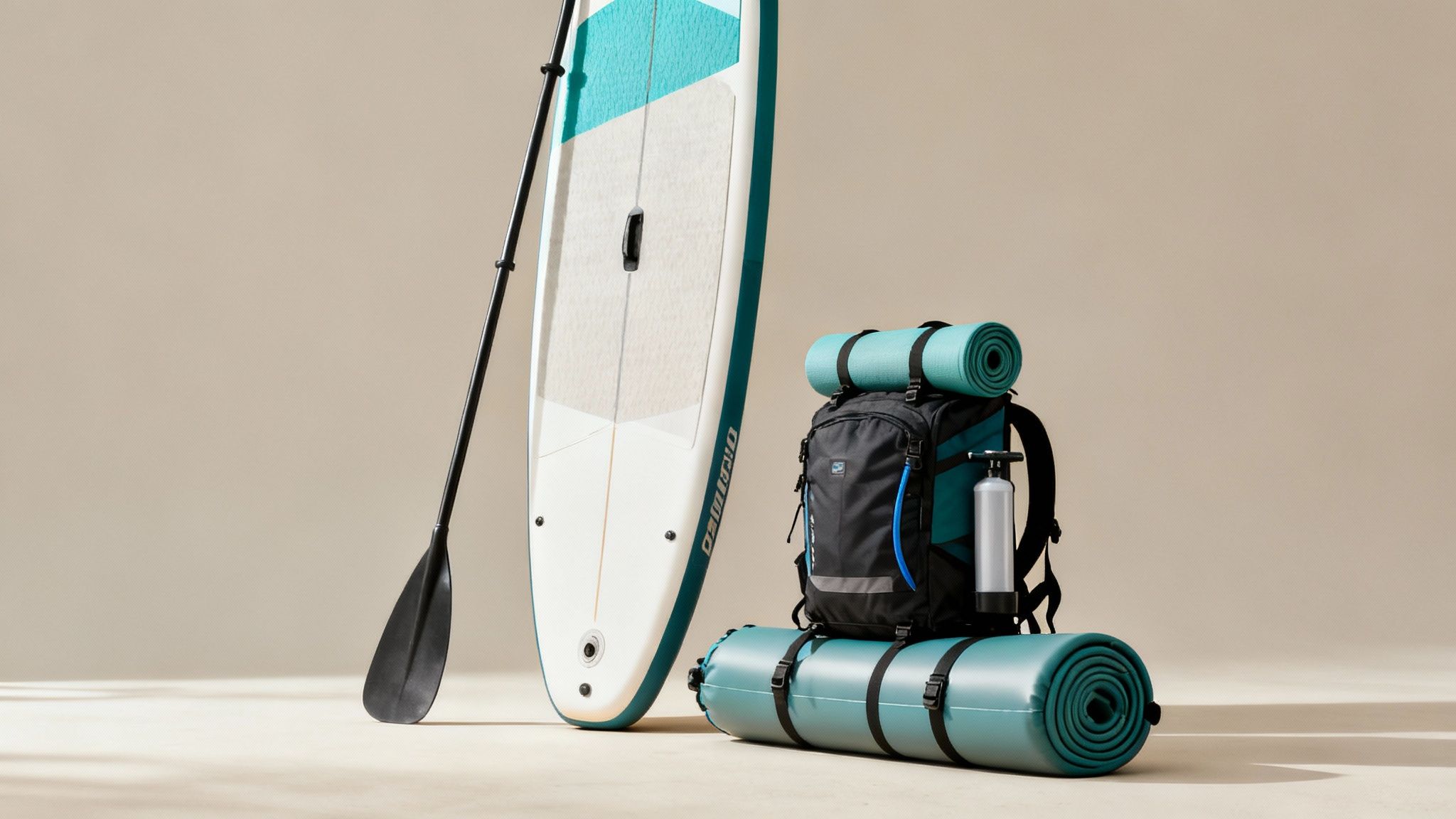
So, you've got a handle on how a board's dimensions shape its personality on the water. Now for one of the biggest decisions you'll make: choosing between a classic hard board and a modern inflatable (iSUP). Each has its own character and strengths, so the best choice really boils down to your lifestyle, where you'll store it, and what you want to achieve on the water.
The explosion of inflatable technology has completely opened up the world of paddleboarding, making it more accessible than ever before. For those of us without a dedicated garage or a van to haul gear around, the benefits are massive.
The Case for Inflatable SUPs
Inflatable stand-up paddle boards (iSUPs) have become wildly popular, and for very good reason. Their convenience is just in a league of its own.
- Ultimate Portability: An iSUP deflates, rolls up, and fits neatly into a large backpack. You can chuck it in the boot of a Mini, carry it on a train, or even check it in as luggage for a holiday.
- Easy Storage: Living in a flat or a house that's already bursting at the seams? Not a problem. An inflatable can be tucked away in a cupboard or slid under a bed, removing what used to be a huge barrier for many aspiring paddlers.
- Impressive Durability: Don't mistake 'inflatable' for 'fragile'. Modern iSUPs are built like tanks, using military-grade PVC and drop-stitch technology. They're incredibly rigid when pumped up and can shrug off bumps and scrapes that would leave a nasty ding in a traditional hard board.
Take a Loco Air iSUP, for example. It packs down into its own bag, making it the perfect solution for anyone in the UK who's keen on adventure but short on space for a 10-foot solid object. This convenience is the single biggest reason why inflatables are now the first choice for most recreational paddlers.
In fact, the shift in the UK has been huge. Inflatable boards now make up over 70% of all paddle board sales in the country. This trend highlights just how much British paddlers value portability and straightforward fun.
When a Hard Board Is the Better Choice
While inflatables are the undisputed champions of convenience, hard boards still have a crucial role to play, especially when performance is what truly matters.
A hard board, typically built from materials like epoxy, fibreglass, carbon fibre, or even wood, offers a connection to the water that an inflatable just can't replicate. That rigid structure means better responsiveness and a much smoother glide.
Key Insight: Think of it like this: an inflatable is like a brilliant, go-anywhere mountain bike, while a hard board is a sleek, specialist road racing bike. Both are fantastic, but they're engineered for completely different feelings. The mountain bike is versatile and forgiving; the road bike is all about pure, uncompromised performance.
This is exactly why you'll see serious racers and dedicated SUP surfers sticking with hard boards. They simply offer:
- Superior Glide and Speed: The rigid hull slices through the water with minimal resistance, meaning you travel further and faster with every single stroke.
- Enhanced Responsiveness: Hard boards react the instant you shift your weight, giving you that razor-sharp control needed for carving a turn on a wave or making quick adjustments in a race.
- Refined Shapes: The manufacturing process allows for much more complex and subtle designs, like super-thin rails for gripping a wave face or intricate displacement hulls for elite racing.
So, how do you make the call? If easy transport, simple storage, and fun on lakes and calm seas are your main goals, an iSUP is almost certainly your best bet. But if you're dreaming of racing podiums or spending your weekends catching waves, the performance kick from a hard board is impossible to ignore. For a deeper dive into this, check out our article comparing Loco hard SUPs vs inflatable SUPs.
Sizing Up for Real-World Paddling
Getting the basic formula right—matching your weight and skill to a board's volume—gets you most of the way there. But let's be honest, paddleboarding happens out on the water, not on a spreadsheet. A few real-world factors can make all the difference, turning a good board choice into the perfect one.
Think of the basic size calculation as picking the right engine for a car. Now we need to think about the roads you'll be driving on and how much gear you plan to chuck in the boot.
Don't Forget the Extra Cargo
One of the best things about paddleboarding is that you don't have to go it alone. Many of us love bringing along a small co-pilot, whether that’s a child perched on the front or a furry first mate enjoying the ride. You might also want to load up with a cool box, fishing tackle, or even camping gear for a proper adventure.
Every extra kilogram you put on that board affects its stability and how it sits in the water. This is where you need to look past your own body weight and figure out your total paddling weight.
Here's a quick example: Let's say you weigh 80kg, your kid is 25kg, and your dry bag with lunch is 5kg. Suddenly, your total paddling weight is 110kg. That new number is what you should use to find the right board volume, which will likely point you towards a bigger, more stable ride.
A good rule of thumb is to add an extra 20-25 litres of volume for every 10kg of gear you plan to carry regularly. This will keep the board feeling planted and stable. A board like the Loco Amigo Air is a great shout here, with plenty of volume and multiple tie-down points for family days out or gear-heavy trips.
How Paddling Conditions Change the Game
Where you paddle is just as crucial as what you weigh. The glassy, calm surface of a sheltered lake poses a very different challenge to the choppy, wind-battered water of a coastal bay.
- Choppy Water and Wind: Unpredictable conditions demand stability above all else. A wider board (think 33" or 34") gives you a much more solid platform underfoot, stopping you from feeling wobbly when things get rough. Sure, a narrow board is faster, but you'll burn all your energy just trying to stay upright, and that’s no fun for anyone.
- Calm, Flat Water: If you're mainly paddling on serene rivers or lakes, you can get away with something a bit narrower and sleeker. This will reward you with better glide and speed, making it easier to cover distance without feeling like you're pushing a barge.
The UK's waterways are a perfect illustration of this. The market is flooded with a huge variety of board sizes because our local conditions are so changeable, from tranquil canals to gnarly sea swells. In fact, within Europe, the UK accounts for a hefty 14.36% share of composite (solid) board sales, which just shows how popular the sport is here and the need for the right tool for the job. You can dig deeper into these stand-up paddle board market trends if you're curious.
Your Height and Paddling Ambitions
Last but not least, think about yourself and where you want this sport to take you.
Your height directly impacts your centre of gravity. Taller riders—anyone over 6 feet (183 cm)—have a higher centre of gravity, which can make a narrow board feel twitchy and unstable. Simply choosing a board that's an inch or two wider can give you that sure-footed confidence you need.
And what about the future? Are you dreaming of catching your first wave, or are multi-day touring expeditions on your bucket list? If you have a specific goal in mind, choosing a versatile board from the Loco SUP range can help you grow. An all-rounder is a brilliant starting point, but if you know you want to specialise, picking a board that leans towards that discipline will help you progress much faster when you're ready.
Your Final SUP Sizing Checklist
Alright, let's tie everything together into a simple, final checklist. Think of this as your last once-over before you commit, making sure you’ve ticked all the boxes from this guide. It’s all about translating what you’ve learned into a confident choice.
Running through these points will cement the key lessons in your mind and ensure the board you end up with is the perfect partner for your adventures on the water.
The Four Essential Checks
Before you hit 'buy', just quickly run through these four critical points. They're a neat summary of everything we've talked about and form the bedrock of a smart purchase.
-
Calculate Your Total Paddling Weight: This is a big one. It's not just about you. Factor in the weight of your gear, your dog if they're coming along, or even a small child. This is the real-world weight your board needs to handle with ease.
-
Be Honest About Your Skill Level: Are you a complete beginner who needs all the stability you can get? Or are you an intermediate paddler itching for a board with a bit more get-up-and-go? Your honest answer here points you directly to the right volume and width.
-
Define Your Primary Paddling Activity: What’s your main reason for getting out there? Will you be cruising on calm lakes, heading out on long-distance tours, or trying your hand at catching a few waves? A great all-rounder like the Loco Amigo Air covers a lot of bases, but if you have a specific passion, a purpose-built board will serve you much better.
-
Inflatable or Hard Board: This decision really boils down to your lifestyle. Do you need the incredible grab-and-go convenience of an inflatable for easy storage and transport? Or are you chasing performance in surf or racing, where a rigid hard board is king?
The Golden Rule: If you find yourself stuck between two sizes, always choose the larger one. Trust me on this. A bit of extra volume and stability will make your first paddles so much more enjoyable. A board that's too small will feel wobbly and frustrating, and that’s the last thing you want when you’re starting out.
Once you've gone through this checklist, you're in a fantastic position to pick the perfect board. You now get how weight, skill, conditions, and board shape all work together.
Ready to find your match? You can explore the full Loco SUP range right here. And if you still have any nagging questions, our team of experts is always on hand to give you personalised advice and get you out on the water.
Got a Few More Questions About SUP Sizing?
Even with all the charts and numbers, a few specific questions always seem to pop up right when you’re ready to pull the trigger. Let's tackle those common head-scratchers so you can choose your perfect board with total confidence.
What If I'm Between Two Board Sizes?
This is probably the most common dilemma we hear, but the answer is usually straightforward: if you find yourself stuck between two sizes, it's almost always better to go for the larger board. A little extra volume goes a long way, giving you a serious boost in stability and buoyancy.
That extra stability is a massive advantage when you're starting out or if you find yourself paddling in choppy water. It helps you build confidence much faster and makes those first few sessions way more fun. Plus, it gives you the option to carry some gear or even a small passenger down the line. The smaller board might feel a touch more nimble later on, but the immediate enjoyment you'll get from a stable platform is priceless.
Does My Height Matter When Choosing A SUP?
While your weight is the main driver for figuring out the volume you need, your height definitely plays a part in your overall stability. Taller riders naturally have a higher centre of gravity, which can make a narrow board feel surprisingly wobbly and unstable.
If you're over 6 feet (183 cm) tall, you'll likely feel much more planted and secure on a board that’s a bit wider, somewhere in the 33"-34" range. Think of it like a tall building needing a wider foundation to stay solid. Your weight still dictates the board's volume, but your height should nudge you towards a bit more width.
Can One SUP Board Really Work For Multiple Activities?
Yes, absolutely! This is exactly what a good all-round board is designed for. A versatile model like our Loco Amigo Air is built for this kind of adaptability. It’s stable enough for you to have a go at some yoga poses and has plenty of glide for a relaxed tour around a lake or along a calm coastline.
Of course, as you get more into the sport, you’ll begin to appreciate the benefits of specialised kit. A dedicated touring board will be faster and track straighter, while a purpose-built yoga board will be wider and more stable. For most paddlers just starting their journey, though, an all-rounder is the perfect do-it-all board to get you on the water.
How Much Weight Can A Paddle Board Actually Hold?
Every board has a maximum weight capacity listed by the manufacturer, but for the best on-water experience, you should pay more attention to the 'recommended rider weight'. This is the number that really matters for performance.
A brilliant rule of thumb for beginners is to find a board with a volume in litres that is at least double your weight in kilograms. For example, an 80kg rider should be looking for a board with 160L of volume or more.
Following this guideline ensures the board floats nice and high on the water, giving you the best possible stability and glide. If you push past the recommended rider weight, the board will sit too low in the water, becoming sluggish, unstable, and a real chore to paddle.
Feeling ready to find your perfect ride? At Loco Surfing, we've poured over 18 years of passion and expertise into crafting boards that make every moment on the water better. Explore our full range of SUPs today.


